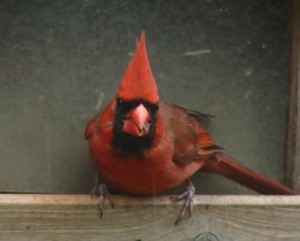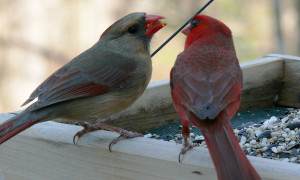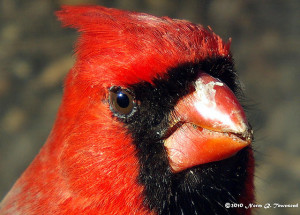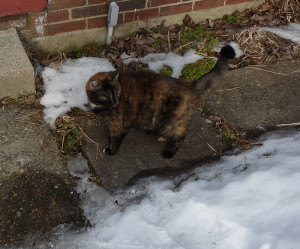Back in early December in response to the Signs of Winter #4 blog about dark-eyed juncos, Irene Wolf, a teaching colleague at Penn State, asked about the cardinals she was seeing in Cheswick. It was hard to believe, she wrote, that these beautiful birds were hardy enough to survive our harsh winters. Could they be some other species?
Nope. They are cardinals!
The northern cardinal (Cardinalis cardinalis) is one of the most recognizable birds in North America. The bright red body feathers and distinctive black mask of the male and the more subdued but equally elegant olive brown and red-tinted feathers of the females stand out clearly in their wide range of preferred habitats. They are very abundant in the edges of woods and thickets, in open fields, in suburban yards and gardens, and in a wide variety of urban green spaces.
The northern cardinal is found throughout the eastern United States and on south into Mexico and Central America. Historically, cardinals were most numerous in the southern portions of their geographic range, but they have been steadily increasing in numbers in the north and are even expanding their distribution northward into northern New England and southern Canada. The western boundary of their range is roughly along a line from the Dakotas to western Texas although there are cardinal populations in New Mexico, southern Arizona, and California. There are cardinals in northwestern Iowa. I remember my Uncle Harold talking about how much he liked “those red birds” that visited his farm out in Humboldt County. I remember standing out in his yard watching small groups of bright red cardinals mixed in with large flocks of cedar waxwings.
The expanding distribution of the northern cardinal has been described by some as another ecological consequence of global warming. Some researchers, though, feel that the increasing popular hobby of providing birds with seed in feeders may have allowed this species to thrive in regions previously too marginal or too harsh for their survival. Further, the ongoing fragmentation of natural forest habitats by human activity and the proliferation of suburban shrub and conifer plantings have created increasingly abundant “edge” ecosystems which are greatly favored by this species.
The northern cardinal eats a wide variety of seeds (including those from pine trees, smartweed, blindweed, foxtail, dock, thistle, chickweed, button weed, sorrel, and a great variety of grasses), fruits (including grapes, dogwood fruit, blackberries, cherries, and raspberries), and even the buds of some trees (including elm and chokecherry). They also eat insects and, in fact, rely almost exclusively on insects as food for their rapidly growing young.
Cardinals are also very common visitors to backyard bird feeders and avidly consume large quantities of sunflower seeds. In fact, if you put a bird feeder with a bird seed mix that does not include sunflower seeds, you are very likely to not attract very many cardinals! The northern cardinal is not migratory and will remain even in the most stressful parts of its geographic range throughout the winter if it is sustained by human-maintained bird feeders.
Our front yard bird feeders are visited by an abundant number of cardinals throughout the year. In the spring males perch on top of the tallest trees around the edges of the yard and sing their pulsing, territory songs. Mated pairs frequently have three clutches of eggs and can be seen throughout the summer frantically feeding their fledglings on every surrounding branch and fence post. The nurturing compulsion of this species is legendary. Someone once even observed a compulsive parental cardinal trying to feed seeds to surface gaping goldfish in a garden fish pond!
The arbor vitae on the west side of our property, and the spruces and hemlocks on the north and west boundaries are full of cardinal nests throughout the summer and are packed with night roosting individuals throughout the winter. In the winter we often have twenty or thirty cardinal at a time swarming the perches of the front yard seed hoppers and the piles of spilled seed on the ground below them. The red males light up the gray days and stand out electrically against the brown leaves and the scattered, white snow.
Northern cardinals are preyed upon by owls, small hawks, and house cats. I frequently find bright red feathers in piles below perches used by our pair of sharp-shinned hawks. My cats (which whom I just celebrated our third annual House Cat Day on February 2!) are both too fat and too addicted to crunchy, dry cat food to pay much attention to quick moving birds! Cardinal nests may be raided by chipmunks, blue jays, crows, and a variety of snakes. Two summers ago I described a cardinal nest built out in a spruce tree just outside my back window that was raided and destroyed by cows and blue jays. Also, cowbirds are common nest parasites, and northern cardinals complete with catbirds and mockingbirds for nesting sites.
On average, northern cardinals live for 3 years in the wild although several individuals have had life spans of 13 to 15 years. The longevity record for a captive northern cardinal is 28 ½ years! It is nice to think that the cardinals we watch each winter and summer will be around with us for several years to come!
House Cat Day results varied across the country. In the warm, sunny southwest (Albuquerque, NM) my daughter
Marian’s cats (Binx and Mora pictured above) spent their House Cat Day lounging outside on a picnic table, seeing their shadows, but not reacting to them in any way at all. Analysis: an early spring in New Mexico.
In Apollo, Pennsylvania Mazie went out (on February 3 because of very lousy weather on the 2nd!) and immediately ran for the open porch door. Analysis: six more weeks of winter for us!






Finally, this summer of 2016, a family of cardinals (possibly two) are continuously returning to our feeders. Some weeks ago there was that moment when the parents arrived with their babies who were really just the tiniest of creatures. I was fortunate to be sipping a drink on my patio when they all arrived. Since then the babies have indeed grown but one in particular is a bit odd. It has a melodic chirp, more like a song and until a week or so ago would not land on a feeder to eat. He/she would sit atop the feeder post while the mother would grab food from the a feeder and then feed it to the baby. Thing is, the ‘baby’ is the size of the mother. Anyway it has been a delight which I hope continues.